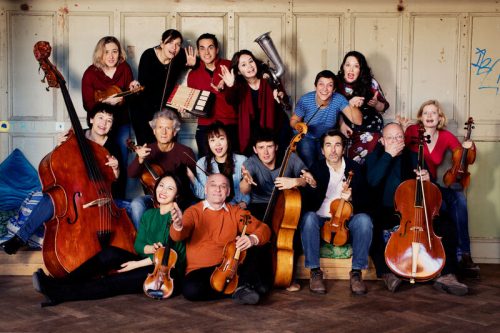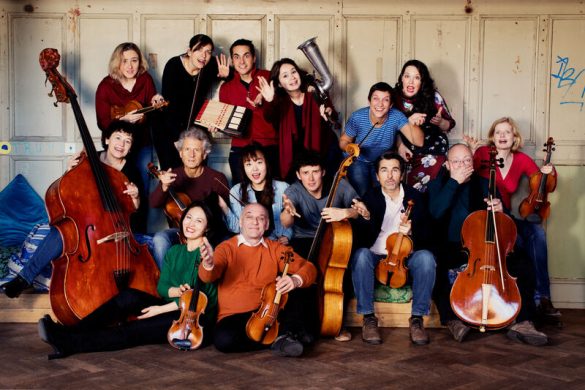
 United Kingdom Edinburgh International Festival 2023 [18]: Camerate Bern, Christian Tetzlaff (violin / director), René Liebert (video installation). Queen’s Hall, Edinburgh, 26.8.2023. (SRT)
United Kingdom Edinburgh International Festival 2023 [18]: Camerate Bern, Christian Tetzlaff (violin / director), René Liebert (video installation). Queen’s Hall, Edinburgh, 26.8.2023. (SRT)

Haydn – The Seven Last Words of our Saviour on the Cross
I should probably just come out and say it: Haydn’s The Seven Last Words puts me to sleep. The number of performances I have sat through expecting, hoping, yearning to be moved and stirred but instead ending up bored senseless by an unremitting series of slow movements. The composer himself acknowledged the problem saying, ‘it was no easy task to compose seven Adagios each and to succeed one another without fatiguing the listeners.’ Well, you should have tried harder, Joseph. Never was an earthquake more longed-for than the one that ends this sequence.
So why did I go to this performance? Because of the promise of something different. The ‘refreshing new guise’ promised by this artistic collaboration made me dare to hope that I would finally encounter a presentation of the Seven Last Words that would make me realise what I was missing. Dreamt up by Patricia Kopatchinskaja (PatKop, as she is affectionately known) and the musicians of Camerata Bern, this presentation of the music in collaboration with a video and lighting design by René Liebert promised ‘a thought-provoking and unforgettable experience’ that would relate ‘the work to the present day and the current state of the world.’
Did it work? Did it heck. In the event PatKop didn’t show up, and her place was taken by another star violinist, Christian Tetzlaff, though he must have wondered why he had bothered because he had no more of the limelight than any other performer: any competent violinist could have done it, and the Camerata Bern could just as well have replaced PatKop with its own leader.
Anyway, as we entered the darkened Queen’s Hall we were greeted with music stands shrouded in sheets and a huge black floor-to-ceiling cloth that wasn’t dissimilar to the composer’s own famous description of the Cádiz church for which he wrote the piece. Three more white sheets were suspended from stands to act as screens and looked like the three crosses of Calvary. The hall was darkened and the performers entered, though the setup was accident-prone from the beginning: a music stand inevitably keeled over as it was being de-veiled, and the tech people didn’t seem to be able to get the three screens to settle at the correct height.
And that was before the projections even began. Liebert’s videos all had a focus on how terrible modern life is, with a particular (though not exclusive) focus on climate change. We saw Californian redwood trees being felled before ‘Father, forgive them’ (get it?) and a torrent of newspaper and social media slogans before ‘Today you will be with me in paradise,’ which presumably offered a release from all that. It all got very predictable very quickly, and also a bit daft, not least the sounding of a real siren before the final earthquake movement. I finally lost patience at the sound of a funeral bell tolling over pictures of plastic in the sea. Subtle this was not.
Next to all this the music was almost incidental. The score was arranged for fourteen players, including a double bass, giving it a startlingly rich quality that I had never experienced before. It also allowed for some extra light and shade as occasional solos for smaller groups of instruments wove in and out of the greater texture.
But it could never solve the eight-Adagios-and-an-earthquake problem, and on this occasion my longing for the exit was as much because of the visuals as the music. ‘It is finished’ isn’t so much a movement title as an expression of relief. If this realisation of the work didn’t convert me then I doubt anything ever will.
Simon Thompson

It sounds to me that you have not heard Haydn’s original orchestral version. My heart sank when I attended this performance and realised that there were to be no flutes, oboes, bassoons, trumpets, horns and timpani. So we were given the string quartet version ‘on steroids’ and it was well played, I admit, but I felt I had been sold a pig in a poke.
I too felt the audio visual aspect and its ecological message did not sit particularly well with Haydn’s religious music and the Festival’s theme of trying to appreciate the point of view of others, as stated in the programme, was ironic in that we in our secular age were not being asked to explore eighteenth-century devotional music. Instead Haydn’s music was being forced into a format to serve twenty-first-century ‘relevance’.